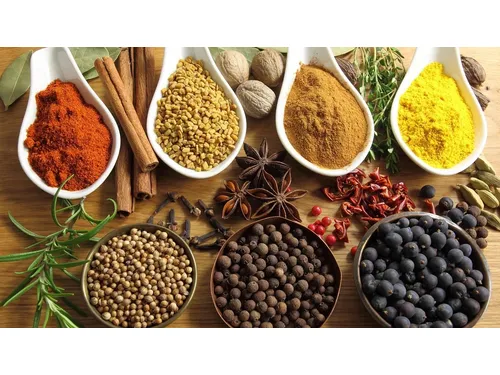
A Guide to Bengali Spices: Flavors, Uses, and Benefits
Bengali cuisine is known for its rich and complex flavors, made possible by a unique blend of spices. These spices not only enhance taste but also offer various health benefits. In this post, we’ll explore some of the most essential Bengali spices, their uses, and why they matter in traditional and modern cooking.
1. Panch Phoron – The Five-Spice Blend
Panch Phoron is a signature spice blend in Bengali cooking. It consists of five whole spices:
- Fenugreek (Methi) – Adds bitterness and aids digestion.
- Nigella Seeds (Kalonji) – Offers a slightly onion-like taste and is rich in antioxidants.
- Cumin Seeds (Jeera) – Enhances aroma and improves gut health.
- Fennel Seeds (Saunf) – Imparts sweetness and helps digestion.
- Mustard Seeds (Sarson/Rai) – Adds pungency and boosts metabolism.
🔹 How it’s used: Often tempered in oil at the start of cooking to release its fragrance. Used in dals, fish curries, and vegetable dishes.
2. Radhuni – The Bengali Celery Seed
Radhuni is an essential spice that resembles celery seeds but has a stronger aroma. It is unique to Bengali cuisine and is often confused with ajwain.
🔹 How it’s used:
- Added to dal and shukto (a traditional mixed vegetable dish).
- Used as a tempering in mustard-based curries.
💡 Tip: Lightly roast before using to enhance its flavor.
3. Shorshe (Mustard Seeds and Mustard Paste)
Mustard is the heart of Bengali cuisine, used in whole, crushed, and paste forms.
🔹 How it’s used:
- Whole mustard seeds are tempered in oil for curries.
- Mustard paste (shorshe bata) is used in famous dishes like Shorshe Ilish (Hilsa fish in mustard gravy).
- Mixed with mustard oil and green chilies to create pungent sauces.
🔥 Fun Fact: Mustard oil, with its strong aroma and antibacterial properties, is a staple in Bengali kitchens.
4. Poppy Seeds (Posto)
Poppy seeds are a key ingredient in Bengali comfort food. They have a mild, nutty flavor and create a creamy texture when ground into a paste.
🔹 How it’s used:
- Posto bata (poppy seed paste) is mixed with mustard oil and green chilies for a simple yet flavorful side dish.
- Used in dishes like Aloo Posto (potatoes in poppy seed paste).
🌿 Health Benefits: Rich in calcium, magnesium, and essential fatty acids.
5. Bay Leaves (Tej Patta)
Bengali bay leaves have a distinct fragrance that differs from the commonly used Mediterranean bay leaf.
🔹 How it’s used:
- Added to rice dishes like pulao and khichuri.
- Used in slow-cooked meat and fish curries to enhance aroma.
🍛 Pro Tip: Fry bay leaves in oil before adding other spices to unlock their full fragrance.
6. Dried Red Chilies and Green Chilies
Bengali food is known for its subtle yet spicy undertones, often achieved through a balance of dried red chilies and fresh green chilies.
🔹 How they’re used:
- Dried red chilies are tempered in oil for dals and curries.
- Green chilies are added fresh for heat and aroma, especially in mustard-based dishes.
🌶 Did you know? Bengali green chilies have a distinct aroma that adds depth to a dish’s flavor without overpowering it.
7. Garam Masala (Bengali Version)
Bengali garam masala is a simple yet aromatic mix of just three key spices:
- Cardamom (Elaichi) – Sweet and floral aroma.
- Cinnamon (Dalchini) – Adds warmth and depth.
- Cloves (Laung) – Enhances richness and complexity.
🔹 How it’s used:
- Sprinkled at the end of cooking to preserve its aroma.
- Used in festive dishes like biryani, kosha mangsho (spicy mutton curry), and chingri malai curry (prawn coconut curry).
🍲 Tip: Unlike North Indian garam masala, the Bengali version is mild and should be used sparingly.
8. Turmeric (Haldi) – The Golden Spice
Turmeric is a staple in almost every Bengali dish, giving food its vibrant yellow color and numerous health benefits.
🔹 How it’s used:
- Added to vegetables, fish, and meat for color and mild earthiness.
- Used as an antiseptic marinade for fish before frying.
💛 Health Benefits: Anti-inflammatory, boosts immunity, and aids digestion.
9. Coriander (Dhone) – Seeds and Leaves
Both coriander seeds and fresh leaves play an important role in Bengali cooking.
🔹 How it’s used:
- Ground coriander is used in spice blends.
- Fresh leaves are used as garnish in dals and curries.
🌿 Flavor Profile: Adds freshness and a hint of citrus.
10. Mace & Nutmeg (Javitri & Jaiphal)
These aromatic spices are often used in festive and rich dishes.
🔹 How they’re used:
- Javitri (mace) is used in pulao and meat curries.
- Jaiphal (nutmeg) is grated into desserts like payesh (rice pudding).
🥮 Pro Tip: A little goes a long way—use sparingly for a subtle depth of flavor.
Final Thoughts
Bengali spices are more than just ingredients; they define the region’s culinary identity. Whether you’re making a comforting bowl of dal, a spicy fish curry, or an indulgent biryani, these spices bring out the magic in every dish.


